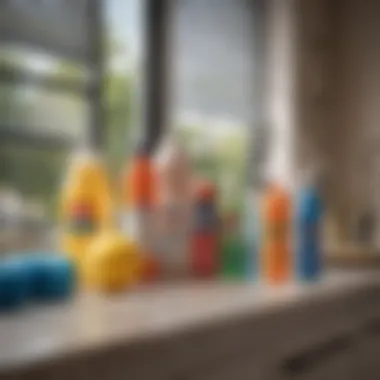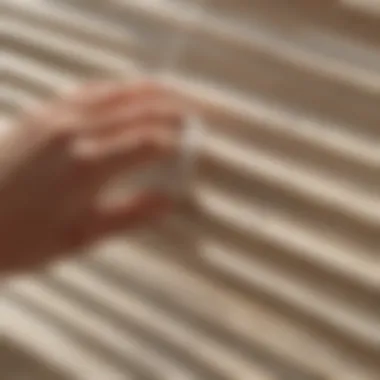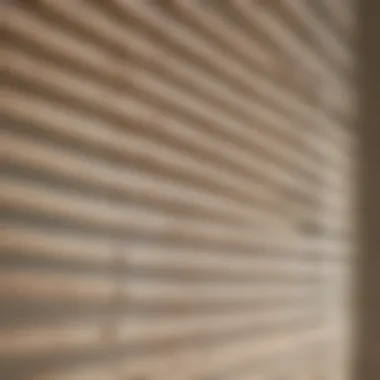Comprehensive Guide to Cleaning Your Blinds at Home


Intro
Understanding how to keep your blinds clean is more important than many realize. Blinds collect dust, allergens, and grease, impacting indoor air quality. In addition, the appearance of dirty blinds can detract from your home's visual appeal. This guide will provide a step-by-step approach to cleaning various types of blinds, using suitable materials and methods. With proper maintenance, blinds can enhance the aesthetic value of any room while contributing to a healthier environment.
Feature Spotlight
Importance of Clean Blinds
Regular cleaning of blinds is essential for both functionality and decor. Clean blinds allow natural light to filter through without obstruction. This enhances the ambiance of the room, complementing existing color schemes and design elements.
Additionally, maintaining this household item prevents long-term damage. Dust accumulation can lead to corrosion or discoloration, especially in wooden and metal blinds.
By outlining specific approaches for different materials, this guide aims to ensure all readers can achieve a spotless finish on their blinds.
Suitable Cleaning Materials
Choosing appropriate cleaning materials is crucial. The right products can determine the effectiveness of the cleaning process. For various types of blinds, you may need:
- Microfiber cloths
- Mild detergents or specialized blind cleaners
- Vinegar solutions for stubborn stains
- Soft brushes for fabric blinds
When possible, avoid harsh chemicals, as they can cause irreversible damage to delicate surfaces. With the right tools in hand, you are prepared to tackle anything from simple dusting to deep cleaning.
Routine Cleaning Methods
Maintaining a regular cleaning schedule helps keep your blinds in optimal condition. Aim for:
- Dusting: Use a microfiber cloth or a duster once a week to remove surface dust.
- Deep Cleaning: Depending on the material, consider deep cleaning every one to three months.
For vinyl and aluminum blinds, a damp cloth with mild detergent works well. For fabric blinds, gentle vacuuming or steam cleaning is recommended. Always check the manufacturer's cleaning instructions before proceeding.
Addressing Common Issues
Stains and marks may require specific solutions. For example:
- Grease: A vinegar and water solution can effectively cut through accumulated grease.
- Stubborn Stains: For persistent stains, consider using baking soda as a paste on the affected area before wiping it away.
Remember, immediate action addresses stains before they set in, preserving the integrity of your blinds.
The End
By following the guidelines presented in this article, homeowners can keep their blinds looking fresh and clean. With regular maintenance and the right cleaning strategies, blinds will continue to be an integral part of your home's design while contributing to overall cleanliness. As you implement these techniques, your living space can reflect the attention to detail you value.
Prelude to Blind Maintenance
Maintaining the cleanliness of blinds is often overlooked in household chores. Yet, understanding the significance of blind maintenance is key to ensuring a comfortable and appealing living space. Dust, allergens, and stains can accumulate on blinds, impacting not just aesthetics but also indoor air quality. Regular cleaning helps to prolong their lifespan and keeps the environment healthy. Neglecting this task can lead to more extensive cleaning efforts later, which can be time-consuming and less effective.
Importance of Clean Blinds
Clean blinds contribute to a polished and tidy appearance. They play a major role in defining the mood of a room. When blinds are dirty, they can diminish the overall impression of cleanliness in your home. Moreover, maintaining clean blinds is essential for health reasons. Dust and allergens can accumulate, affecting respiratory health, especially in individuals with allergies or asthma. Thus, it is beneficial to incorporate blind cleaning into a regular cleaning routine.
Understanding Different Blind Materials
Different materials have unique characteristics that affect their cleaning methods. Knowing the material of your blinds is vital for selecting appropriate cleaning techniques and products.
Wood Blinds
Wood blinds are celebrated for their elegance and warmth. They add a timeless look to any room. However, they require specific care to maintain their beauty. Wood has a natural grain and finish that can be damaged by excessive moisture or harsh chemicals. It is advisable to use a soft, dry cloth for dusting and a suitable wood cleaner for deeper cleaning. Their aesthetic appeal is a defining aspect, but they also require careful handling to avoid warping or peeling.
Vinyl Blinds
Vinyl blinds are appreciated for their durability and ease of maintenance. Their non-porous surface makes them resistant to moisture, which is a great advantage in areas like kitchens and bathrooms. Cleaning them is relatively straightforward; a damp cloth with mild soap usually suffices. One should be cautious not to use abrasive materials, as they may scratch the surface. Vinyl blinds are a popular choice for those seeking a low-maintenance option.
Aluminum Blinds
Aluminum blinds are another low-maintenance alternative. They are lightweight yet highly functional, making them a common choice for many homeowners. Aluminum is resistant to moisture, which prevents rust or corrosion. They are easily cleaned with a damp cloth or a mild cleaning solution. However, care should be taken to avoid bending the slats. The strength and affordability of aluminum blinds make them a practical option, though they may not offer the warmth of wood.
Fabric Blinds
Fabric blinds provide a soft texture and a wide range of designs. They can significantly enhance a room’s decor. However, they tend to attract dust and can stain more easily than other materials. Regular vacuuming is recommended to remove dust. For deeper cleaning, thorough instructions from manufacturers should be followed, as fabric types vary widely. Their aesthetic contribution is significant, but their maintenance level needs careful attention to prolong their appearance.


Preparation for Cleaning
Preparation is a crucial step in the cleaning process. It sets the stage for an effective, efficient, and safe cleaning of your blinds. Without adequate preparation, you may encounter issues like using the wrong cleaning method or neglecting to protect your furnishings. Good prep ensures that you have everything needed to perform the task without interruptions. This makes the overall cleaning experience less stressful and more productive. Investing a few moments to gather the right supplies and follow safety precautions can greatly simplify the job.
Gathering Necessary Supplies
When cleaning blinds, having the right tools and materials is essential. The supplies can make a significant difference in how effectively you clean your blinds.
Cleaning Cloths
Cleaning cloths are a vital part of your supplies. They play a pivotal role in removing dust and grime effectively. A microfiber cloth is often the best option due to its soft texture and ability to capture dirt efficiently. Microfiber's unique structure allows it to trap dust particles without scratching the surfaces of various blind materials. It is also washable and reusable, making it an eco-friendly choice. However, ensure that the cloth is clean before using it; otherwise, it can spread dust instead of removing it.
Appropriate Cleaning Solutions
Selecting the right cleaning solution is critical for maintaining your blinds. Different materials require specific cleaning agents. For example, wood blinds may need a gentle wood cleaner, while vinyl blinds might be fine with a mix of water and mild detergent. This consideration ensures that the integrity of the blind material is preserved. A unique feature of specialized solutions is that they often include protective elements to prevent streaks or damage. Choose cleaning solutions that align with the types of blinds you have. Remember to verify that the solution does not contain harsh chemicals that could potentially harm the blinds.
Vacuum Cleaner with Brush Attachment
A vacuum cleaner with a brush attachment can be a beneficial tool when preparing to clean your blinds. This type of vacuum is designed to efficiently remove dust and debris from fine surfaces like blinds without damaging them. The brush helps loosen dust, making the vacuums work more effectively. Moreover, this method is often quicker than traditional dusting, making it an excellent choice if you have multiple blinds to clean. However, ensure that the brush is soft enough to avoid scratching any delicate materials.
Safety Precautions
Safety precautions are just as important as gathering supplies. They help protect both the surroundings and the individual performing the cleaning tasks.
Protecting Furnishings
During the cleaning process, safeguarding your furnishings is essential. The use of old sheets or drop cloths beneath the blinds can prevent accidental spills or drips from reaching your furniture or floor. This measure ensures that any cleaning solution or water used does not cause water stains or damage. Another key characteristic of protection is to move any fragile items away from the cleaning area. This preventative step can save you from potential mess and damage, allowing you to clean with peace of mind.
Wearing Gloves
Wearing gloves is advisable when cleaning blinds. They act as a barrier, protecting your hands from potential irritants present in cleaning solutions. Certain products can cause skin irritation or allergic reactions, especially during prolonged use. The main advantage of gloves is that they allow a more comfortable grip while cleaning. Additionally, they help maintain hygiene, especially if the blinds have accumulated significant grime. Choose gloves that are durable yet flexible to ensure that you can handle the cleaning tools effectively.
Step-by-Step Cleaning Process
Cleaning your blinds is a task that requires a systematic approach. This section emphasizes the methodical nature of blind cleaning, ensuring that no detail is overlooked. A step-by-step process makes it easier to achieve thorough cleanliness and care for different materials. Each step allows the homeowner to consider the unique requirements of their blinds, ultimately preserving their functionality and appearance.
Dusting Blinds
Dusting is the initial step in keeping blinds clean. Accumulated dust not only impacts the aesthetics but can also affect air quality. Performing this step properly is crucial for effective cleaning.
Using a Microfiber Cloth
Using a microfiber cloth for dusting is a well-rounded choice. Microfiber absorbs dust and grime effectively, making it more efficient than traditional cloths. The unique fibers in a microfiber cloth create a larger surface area that traps dirt, which helps to avoid scattering dust back into the air.
Some advantages include:
- Gentle on Surfaces: The soft material will not scratch the blinds.
- Reusable: They can be washed and used repeatedly, which is cost-effective.
However, the cloth must be kept clean to maintain its effectiveness. Dirty cloths can lead to more grime transfer rather than cleaning.
Employing a Duster
Employing a duster can be another effective method for cleaning blinds. A duster, particularly one with extendable features, can reach areas that are otherwise difficult to access. They are good for quick clean-ups when time is limited.
Key characteristics of a duster include:
- Versatile Reach: Helps to clean high or awkwardly placed blinds without needing a ladder.
- Time Efficient: Often allows for quicker dust removal compared to manual wiping.
On the other hand, dusters may not capture dust as thoroughly as a microfiber cloth. They are better suited for maintenance rather than deep cleaning, which means the dust could settle back onto the blinds over time.
Deep Cleaning Techniques by Material
After dusting, it's important to consider deep cleaning methods tailored to specific blind materials. Each type of blind has unique characteristics that require different techniques.
Wood Blinds Cleaning Method
Cleaning wood blinds requires a gentle touch. Wood can warp or get damaged with excess moisture. The key focus in this method is using products that are safe for wooden surfaces.


Benefits of this method include:
- Preservation: Proper cleaning ensures longevity of the wood.
- Aesthetic Appeal: Clean blinds maintain the natural beauty of wood without unsightly stains.
Always use a slightly damp cloth, avoiding soaking. It helps maintain the finish of the blinds while effectively removing dirt.
Cleaning Vinyl Blinds
Vinyl blinds are more durable and can withstand more moisture than wood. A simple mixture of warm water and mild detergent proves effective in this case. This method emphasizes thorough rinsing to avoid any soap residue.
Highlighting the benefits:
- Easy Maintenance: Resistant to stains and easy to clean with common household items.
- Durability: They hold up better against harsh cleaning products.
However, users should be wary of abrasive products that can scratch vinyl, compromising its appearance.
Aluminum Blinds Maintenance
Aluminum blinds also benefit from regular cleaning. Their metallic surface can be wiped down with a cloth or sponge dipped in soapy water. This method is quite straightforward but it is crucial to dry them properly to prevent water spots.
The advantages include:
- Rust Resistance: Aluminum does not corrode, making it suitable for different environments.
- Lightweight: Easy to handle during the cleaning process.
One disadvantage is that they can dent if mishandled during cleaning.
Fabric Blinds Care
Cleaning fabric blinds requires an approach that is sensitive to the material. Vacuuming can be used to remove surface dust and pet hair. For stains, spot treatments with fabric cleaner can be beneficial.
Key considerations:
- Gentle Approach: The use of harsh chemicals is discouraged as it can damage fabric.
- Soft Handling: Careful treatment ensures the fabric retains its texture and color.
Resolving Common Cleaning Challenges
Cleaning blinds can be especially difficult when dealing with specific challenges such as stubborn stains and accumulated grime. Addressing these challenges is crucial not only for the aesthetic appeal of the blinds but also for maintaining their longevity. By understanding common cleaning issues, you can employ effective techniques and products to restore your blinds to their original condition. This section aims to provide insights and solutions for these frequent problems, helping homeowners achieve the desired cleanliness and functionality of their window treatments.
Removing Stubborn Stains
Stains can be an eyesore on otherwise clean blinds. Identifying the types of stains affecting your blinds is the first step towards effective cleaning.
Identifying Types of Stains
Stains on blinds can vary from dust and dirt to more challenging substances such as grease or ink. The ability to identify the type of stain present is important. Each stain type requires a different cleaning approach to restore the blind's appearance without causing damage. The key characteristic of identifying stains is understanding their source, as it influences the method and cleaning agent to use. This focus on stain identification is beneficial. By knowing the specific stain, you can choose an appropriate cleaning technique and product.
Some common stains include:
- Grease from cooking
- Mildew from humidity
- Ink from pens
- General dust and dirt
Identifying these stains helps select the right approach accordingly.
Effective Cleaning Techniques
Once the stain is identified, you can move on to effective cleaning techniques. Different methods cater to various types of stains, making it easier to choose the right one. Using a targeted approach can save time and effort, and it ensures your blinds do not suffer unnecessary damage.
A popular method for treating stubborn stains involves using a diluted mixture of dish soap and warm water for grease or grimy fingerprints.
Key characteristics of these techniques include:
- Targeted application based on the stain type
- Use of gentle solutions to minimize damage
The unique feature of effective cleaning techniques is their adaptability. They allow homeowners to effectively remove stains without needing complicated tools or products. They are often straightforward, which is beneficial across different blind materials.
Dealing with Accumulated Grime
Accumulated grime can dull the appearance of your blinds and even affect their function. Being proactive about tackling grime is essential. There are specific solutions and approaches to combat these buildup challenges.
Preparing a Deep Cleaning Solution


To tackle deep-set grime effectively, preparing a deep cleaning solution can yield positive results. These mixtures often contain more potent cleaning agents and should be used carefully. They can penetrate layers of grime that typical surface cleaning cannot achieve.
A common solution involves combining vinegar and water in equal parts. This mix is particularly effective for many materials while being gentle enough to prevent damage.
Benefits of preparing a deep cleaning solution include:
- Enhanced cleaning power
- Cost-effective and accessible ingredients
The unique feature is that a tailored solution can be made at home, requiring just simple household items. However, caution is necessary to avoid damaging certain materials like fabric or wood.
Utilizing a Steamer
Steam cleaning is another effective option. This method uses hot steam to break down accumulated grime. It can be particularly beneficial for fabric and vinyl blinds. Steam cleaning not only disinfects but also softens grime and dirt particles, making them easier to wipe away.
Key characteristics include:
- Effective removal of grime without chemicals
- Ideal for those seeking a more eco-friendly cleaning solution
Its unique feature lies in its efficiency; steaming allows for deeper cleaning without much scrubbing, saving time. However, some blinds may not be suitable for high heat, so an understanding of your specific blinds is crucial.
Regularly addressing these common cleaning challenges not only prolongs the life of your blinds but also maintains a healthier living environment.
Maintenance Tips for Longevity
Maintaining the cleanliness and function of blinds goes beyond the initial cleaning process. Routine upkeep and preventive measures are critical in extending the lifespan of blinds. Regular maintenance prevents dirt accumulation and promotes a fresher living environment. This section elaborates on methods to enhance the durability and aesthetic of your blinds.
Routine Cleaning Schedule
Frequency Recommendations
A consistent cleaning schedule is vital for blinds' longevity. Depending on the household environment, weekly dusting and monthly deep cleaning are recommended. Homes in dusty areas, or those with pets, may benefit from more frequent cleaning. This frequency limits the gathering of dirt, making it easier to keep blinds looking new. Regular attention also helps to mitigate stains. A crucial benefit of this routine is the reduction of allergens.
Incorporating this habit into cleaning routines is an effective choice. It ensures that blinds are never too dirty, making deep cleaning less daunting. However, the downside can be the time commitment. Finding a balance is key.
Seasonal Cleaning Tips
Adapting cleaning methods to seasonal changes can be highly effective. For instance, spring is an ideal time for thorough cleaning after winter. This includes removing window treatments for a deeper clean, ensuring no dust gets neglected. Furthermore, adjusting the schedule based on seasons can enhance the efficiency of cleaning.
One distinct advantage of seasonal cleaning is its alignment with the general spring cleaning trend. However, it may not fit every lifestyle. It requires planning and sometimes additional resources.
Preventing Dust Buildup
Using Air Purifiers
Air purifiers play a pivotal role in maintaining a clean environment. They filter out dust and allergens, which directly affects blinds' cleanliness. Installing high-quality air purifiers can significantly reduce the dust that settles on surfaces, including your blinds. Their effectiveness is a notable attribute of air purifiers, making them beneficial in homes.
While they provide effective dust control, air purifiers can be an investment. The running costs and regular filter replacements can be considered disadvantages.
Positioning Blinds Effectively
Where and how blinds are positioned can significantly impact their cleanliness. Positioning blinds away from open windows can reduce dust infiltration caused by outside elements. Additionally, adjusting blinds to limit sunlight exposure can mitigate fading and wear.
This strategic placement is a beneficial practice for homeowners. It not only preserves the appearance of blinds but also decreases cleaning frequency. One limitation might be that not all homes can easily alter blind positions, depending on architectural design.
Remember: Regular maintenance of your blinds is paramount in preserving their functionality and aesthetics, requiring both attention and strategy.
By implementing these routines and tips, your blinds can maintain their beauty and longevity.
Ending
In this article, we have explored multiple facets of cleaning and maintaining blinds at home. Maintaining clean blinds is critical for preserving a home’s aesthetic and functional qualities. An often overlooked aspect, regular cleaning can enhance the durability of blinds, reduce allergens in the living space, and contribute to an overall healthier environment.
Recap of Effective Techniques
To summarize, we have discussed important techniques to ensure the effective cleaning of various blind materials. Key methods include:
- Dusting with a Microfiber Cloth: This approach is gentler and prevents scratching of surfaces.
- Deep Cleaning: Tailoring the cleaning method to the material is crucial. For instance, wood blinds require a mild soap solution, while vinyl can withstand more robust cleaning products.
- Utilizing Vacuum Cleaners: Using a vacuum with a brush attachment for dust removal can save time and increase efficiency.
- Steam Cleaning for Fabric Blinds: This method helps in removing stains while also sanitizing the fabric without harsh chemicals.
These techniques, when systematically applied, will not only keep your blinds looking new but also extend their lifespan, creating a win-win situation for homeowners seeking functionality and style in their interiors.
Encouragement for Ongoing Maintenance
Lastly, ongoing maintenance is vital for keeping blinds pristine over time. Setting up a regular cleaning schedule based on the material and location of the blinds prevents the buildup of dust and dirt. Here are some tips to consider:
- Weekly Dusting: A brief routine of dusting once a week can significantly reduce the need for intensive cleaning later on.
- Seasonal Deep Cleaning: Depending on the season, adjust your cleaning methods. For example, spring may require more attention due to pollen accumulation.
- Use of Air Purifiers: Installing air purifiers can help in reducing dust and aiding in overall cleaner interiors.
- Strategic Placement: Positioning blinds strategically can minimize the accumulation of dust, especially in high-traffic areas.
By prioritizing maintenance as a continuous process, homeowners can enjoy a cleaner, more inviting atmosphere while safeguarding their investment in window treatments.







